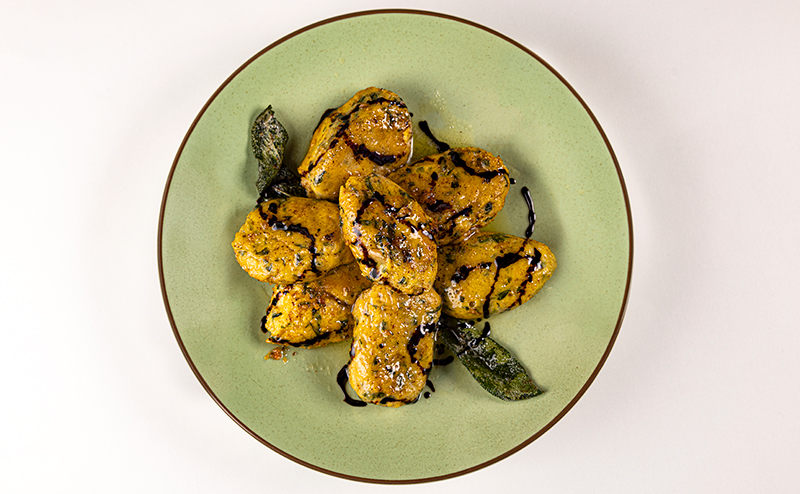
Contrary to the proverb “too many cooks spoil the broth,” I find it fun to collaborate in the kitchen. Earlier this year I was invited to participate in ArtFare, a benefit for the Kansas City Art Institute where Kansas City chefs are paired with artists to create a delicious, stimulating, and entertaining evening. I was paired with artist Dylan Mortimer, whose story and art shimmer with light and life. In addition to Dylan, inspiration for my dish came from an early spring trip to Emilia-Romagna, Italy. For those not familiar, the area is home to many great works of Renaissance art, and a cuisine that during the Renaissance began evolving into dishes we recognize today. Throw in the region’s spectacular Parmigiano-Reggiano cheese and balsamico tradizionale, both ingredients used at that time, and you have a recipe for success.
My dish for ArtFare is a version of gnudi—literally naked ravioli. That means that it’s a ravioli filling not covered with pasta, rather more like a dumpling. Gnudi is normally made with ricotta cheese, a binder, and seasonings. This recipe is loosely based on one I found perusing translations of Renaissance Italian chef Bartolomeo Scappi, one of the earliest writers of cookbooks, or what I think of as vague culinary guidance. (It’s hard to call these really old instructions “recipes” because there is a great deal that is assumed by the writer of the original text concerning the knowledge of the person reading—think instructions like: handful, enough, the correct amount, as needed, herbs of the season, in the normal manner, on fat or lean days, after the fashion of the country folk. You get the idea.) Fortunately, versions of this dish are still being made today, and chemistry being chemistry, proportions in recipes tend to be successful only in certain ratios, so a little experimentation is all that is required to achieve a nice dish. I also wanted to use winter squash, a New-World ingredient just becoming popular in Europe at the time, so I based my version on an average-sized butternut squash I picked up at the OP Farmers Market—the squash beetles and some bastard chipmunks really did a number on my squash this year, so I didn’t have any of my own. Since gnudi is normally made with ricotta, I also used a conveniently packed one pound tub. The remainder of the recipe wrote itself.
For the curious and industrious, read on and give gnudi a try. For the curious but less inclined to actually cooking, I hope to see you at ArtFare where you can taste a slightly more “refined” version of this dish—one with a little more bling than you might want to attempt at home—and you’ll be able to experience the flavors and creations of the other chefs and artists as well. Regardless, I know you will enjoy the collaboration.
Winter Squash Gnudi
Begin by washing a medium-sized butternut squash (mine was 1.75 pounds to start), cut off the stem, carefully split it lengthways, and scoop out the seeds and strings. Lightly oil the squash, season the cut surface with salt and pepper, and place it cut side down on a parchment-lined sheet pan. In a 400F oven, roast the squash until tender (about 45 minutes—the skin should be slightly blistered and the squash tender when prodded with a fork or finger (don’t burn yourself). Allow the squash to cool, then remove the skin (sometimes it is easy to peel skin off the flesh, sometimes it is easier to scoop the flesh out of the skin). Mash or purée the flesh, again season lightly with salt, and allow the squash to drain in cheesecloth or in a colander–it may or may not release much liquid depending on the moisture content of the squash. Out of curiosity, I weighed my drained squash and ended up with about 15 ounces of squash purée (almost 2 cups by volume). If you have any type of leftover roasted winter squash or pumpkin from another meal–even sweet potato—you could use that. Just be sure to drain it.
In a large bowl, combine the squash purée with one pound ricotta (also drained of any excess liquid), one cup grated Grana Padano or Parmigiano-Reggiano cheese, one egg, and about ¼ cup cooked, chopped and drained greens, such as spinach, Swiss chard, kale, or other greens. The original Italian “recipe” referenced “herbs,” which covers a wide range of green things that won’t kill you when eaten (they really like to forage in that part of the world). Swiss chard and spinach are the contemporary plants of choice, but you could certainly experiment with dandelions, parsley, carrot tops, or nettles. As for seasoning, next sprinkle over a little more salt, several generous grinds of black pepper, and then grate in about one third of a nutmeg. Other pumpkin spices i.e., cinnamon cloves or allspice, could be added, but that seems a bit like gilding the lily. When everything is thoroughly combined, sprinkle over one cup of all-purpose flour and gently stir in until the flour is no longer visible—try not to work too much which can toughen the dough and make the dumplings less tender. If the dough seems too wet, you could add a bit more grated cheese or plain breadcrumbs to help absorb excess moisture. Taste, adjusting the seasoning as necessary. Set the mixture in the fridge for a bit while you think about the rest of your meal and debate refilling the glass of wine you’ve been nursing.
When ready to cook, put on a large pot of salted water to a boil. Generously dust a sheet pan with flour and lightly flour your hands. Gather walnut-sized pieces of the sticky dough (about two tablespoons—I like to use an ice cream scoop) and quickly shape them into slightly flattened balls or quenelles, setting them on the floured pan until everything is shaped. Gently drop the gnudi into the boiling water, just a few at a time—you don’t want the temperature of the water to drop too far below the boiling point or the gnudi could dissolve before firming up. Depending on the size of the pot, you may have to do this in two batches. After several minutes (be patient) the gnudi will begin to float to the top. Allow them to bob and continue cooking for about four more minutes until firm. Meanwhile, heat a large skillet (non-stick is nice) with 6 to 8 tablespoons of butter and a few sage leaves until the butter quits sputtering and the solids in the butter begin to turn brown. With a slotted spoon, gently transfer the floating gnudi into the skillet and sauté them for a few minutes in the sage butter. Shake the pan lightly to move the gnudi around so they are coated in butter, take on a deeper golden color, and begin to crisp a bit on the edges (be careful—the ricotta scorches easily). For a creamier sauce, add a few tablespoons of the pasta water and a handful of grated cheese (Grana or Parmigiano), and shake the skillet to emulsify the butter and water. To serve, spoon the gnudi onto warmed plates and lightly drizzle with the finest balsamico tradizionale you can find (or make a syrupy reduction of grocery store-grade balsamic vinegar with a little sugar), sprinkle with more grated cheese, and enjoy. To serve at ArtFare, add a drizzle of turkey demi-glace, fried sage leaves, gold leaf and art. Hope to see you there!
ArtFare, October 19 at the 1900 Building
In Your Pantry
Beyond Canned Pumpkin
Pumpkin and other winter squash are good for more than just Jack O’Lanterns, holiday still lifes, and pumpkin pie. They also have more to offer than just squishy cooked pumpkin flesh. Look for these ingredients in health food and better grocery stores like Sprouts or Whole Foods.
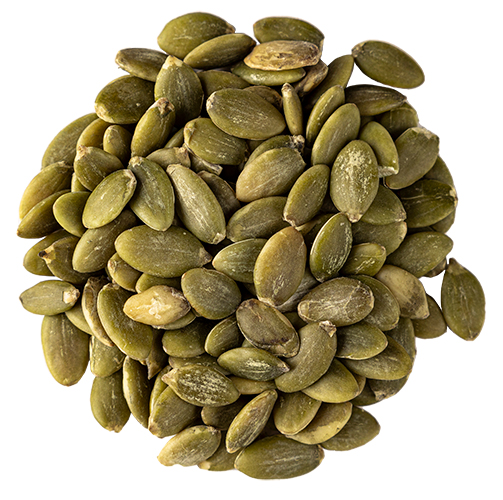 Pumpkin Seeds
Pumpkin Seeds
AKA pepitas, are squash seeds with the outer hull removed (they can be eaten with the hull, but that’s a bit more work). They have a gentle, nutty flavor and are delicious both fresh and roasted, eaten out of hand as a snack. Pumpkin seeds provide a great garnish for any winter squash dish. Try them as an addition to granola or muesli, or sprinkled on pumpkin ice cream, squash risotto, and autumn salads.
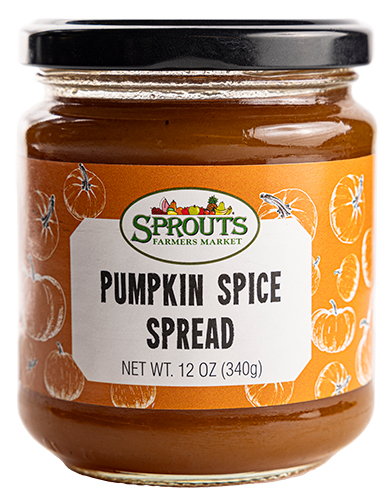 Pumpkin Butter
Pumpkin Butter
One of the few places pumpkin spice actually belongs, pumpkin butter is a great addition to your rotation of spreads for toast or as an impromptu frosting for coffee cakes. Many pumpkin butters have apple as a component because they blend quite harmoniously and add a hint of sweetness. Try it as a filling for fried pies, dolloped onto a steaming bowl of oatmeal, or swirled atop a warm breakfast muffin or afternoon cupcake.
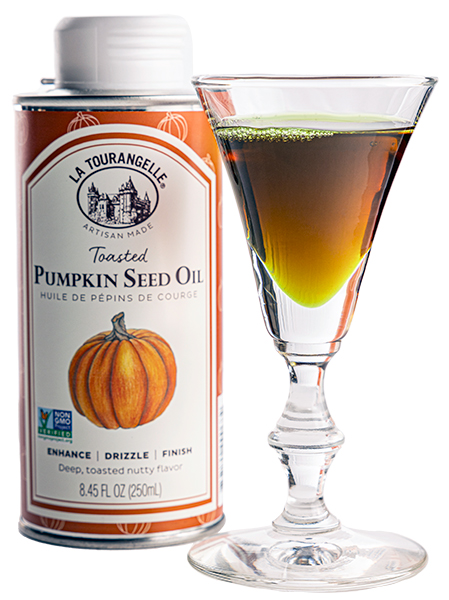 Pumpkin Seed Oil
Pumpkin Seed Oil
Pumpkin seed oil is an especially tasty and nutritious source of many vitamins, minerals, and antioxidants. Try it as an oil for salad dressings or as a finishing oil drizzled over pasta or risotto, grain and pumpkin salads, or soups.
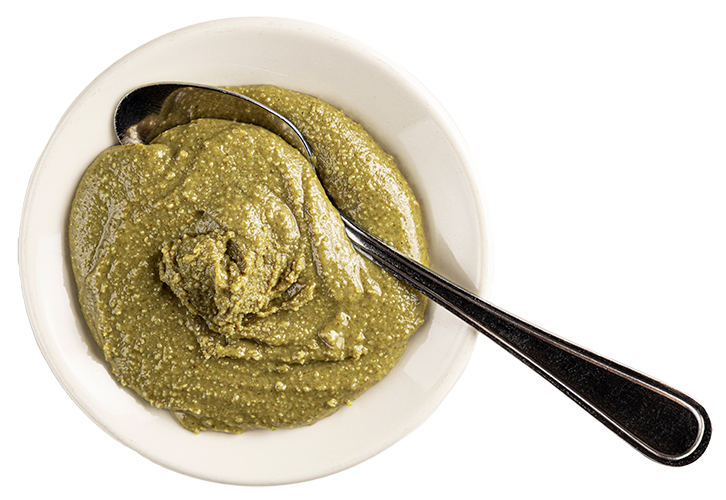 Pumpkin Seed Butter
Pumpkin Seed Butter
It’s like peanut butter—but made from pumpkin seeds. Great for those with peanut and tree-nut allergies. The texture is like natural peanut butter and the flavor is very similar. Try it on a nutritious and seasonal avocado toast, swirled into pumpkin gelato, on a sandwich with Concord grape jelly, in smoothies, or to add body to nutty soups and sauces. For those with a sweet tooth, drizzle the butter with honey or maple syrup (and a sprinkling of flaky salt).


